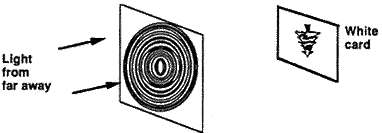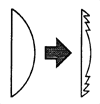EQUIPMENT: Fresnel Lens, Lenses A, B and C, Ruler and White card
|

|
| CAUTION! DO NOT LOOK AT THE SUN!
|
|
|
COMPARE LENSES
|
Look closely and carefully at the Fresnel lens.
1) Tell how the Fresnel lens itself appears different from the
other lenses.
2) Is the Fresnel lens a magnifier? (Look back to Experiment #2
if you have forgotten how to tell.)
|
|
|
FIND THE FOCAL LENGTH
|
In Experiment #1 you found the focal lengths of some of the lenses. Using a small, bright object (such as a light bulb) which is very far from the Fresnel lens, and the white card, find the focal length of the lens.
3) What is the focal length of the Fresnel lens?
|
|
|
MAKE A TELESCOPE
|
The Fresnel lens can be used along with one of the other lenses to make a telescope (see Experiments #3 and #4). Choose one of the other lenses and make a telescope.
4) Figure out which type of telescope (Galilean or Keplerian) you have made and explain how you know.
|
|
HOW IS THIS USEFUL?
|
The Fresnel lens is a "skinny" lens. Only one side of the lens is curved. This side is made up of a series of rings each of which has a curvature that is the same as the curve of a regular lens with the same focal length. The Fresnel lens is often used where a big lens that is light in weight is needed, for instance in lighthouses.
|

|


